SISXCAI304A: Planning Sport and Recreation Program Report
VerifiedAdded on 2022/08/29
|14
|3935
|19
Report
AI Summary
This report details the planning and execution of a six-week soccer program designed for 200 participants of various ages and genders, emphasizing inclusivity and safety. The program addresses participant needs through pre-exercise screening, waiver forms, and questionnaires, aiming to improve fitness, foster competitiveness, and develop social skills. The report outlines program objectives, describes the six-week progression of exercises, and specifies required resources, including equipment, venue, and a $100,000 budget. Risk assessment, safety measures (like protective gear and first aid), and session templates are provided, alongside detailed coaching strategies and conflict resolution methods. The program incorporates various support personnel, including trainers, nutritionists, and physicians, and emphasizes the importance of stakeholder engagement and adherence to relevant policies and procedures. The report also includes session plans that detail warm-up, main body, and cool-down activities, alongside safety considerations and program evaluation strategies. Conflict resolution strategies, policies, and procedures including safety, transparency, emergency procedures and inclusivity and diversity are also discussed.
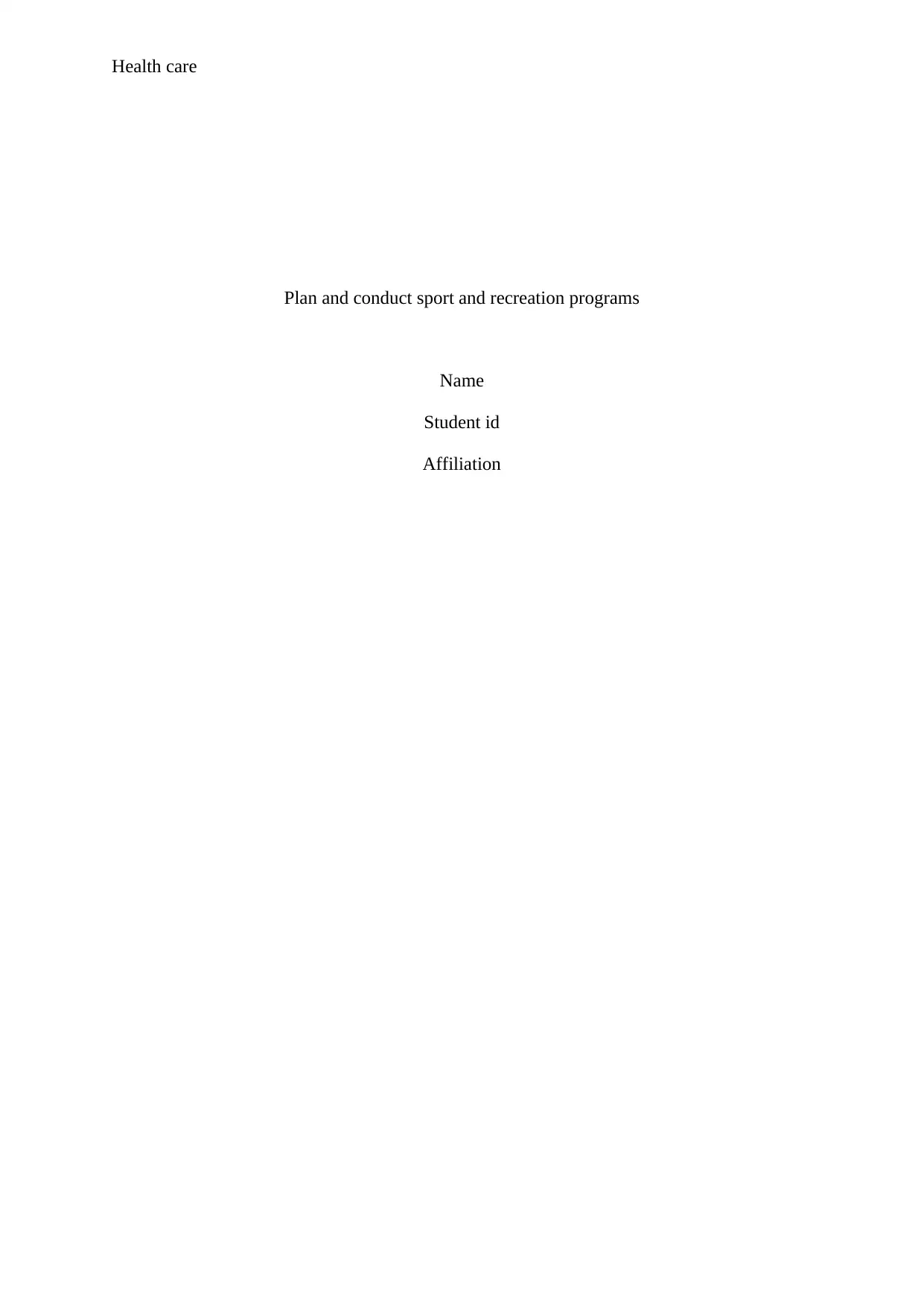
Health care
Plan and conduct sport and recreation programs
Name
Student id
Affiliation
Plan and conduct sport and recreation programs
Name
Student id
Affiliation
Paraphrase This Document
Need a fresh take? Get an instant paraphrase of this document with our AI Paraphraser
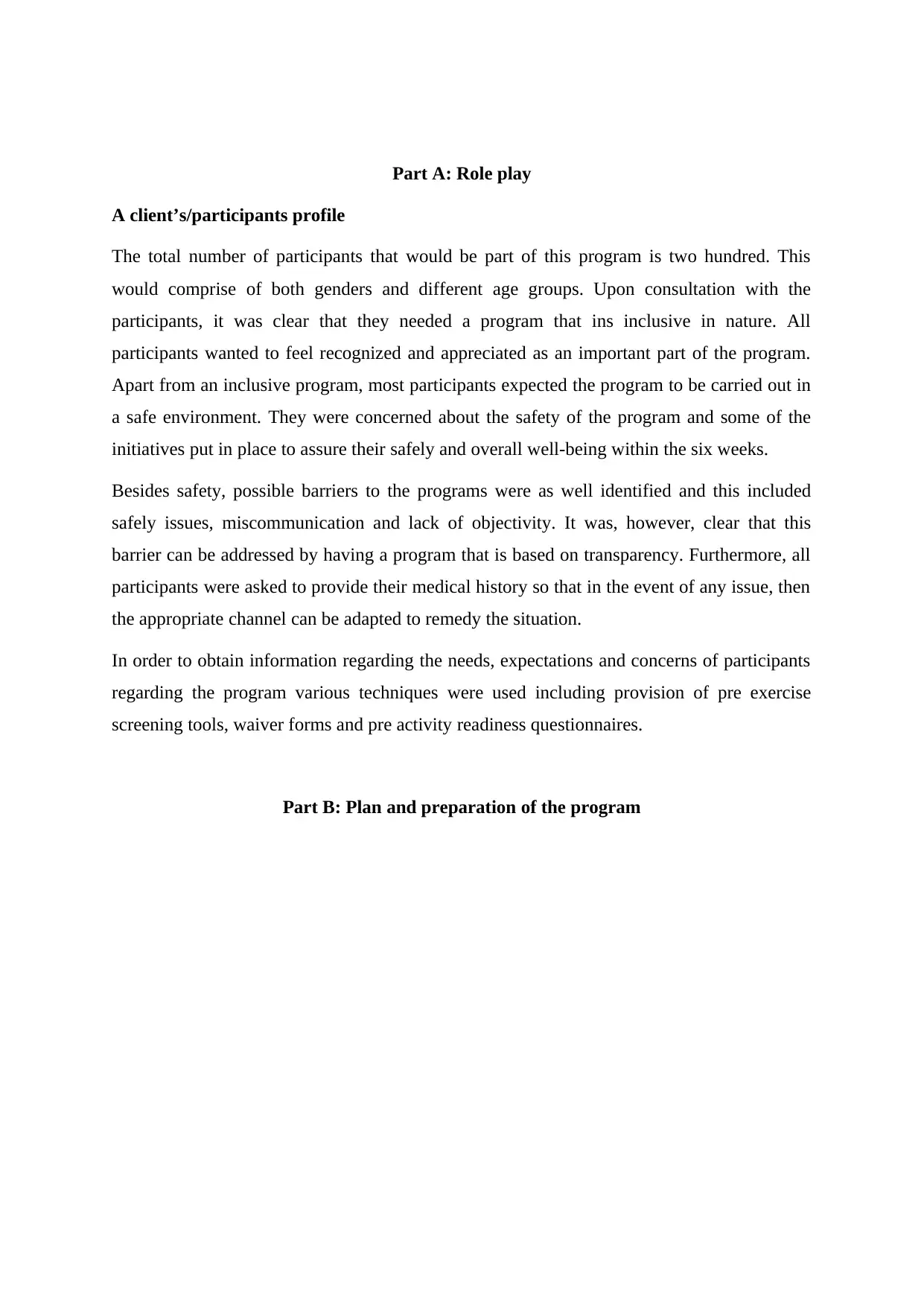
Part A: Role play
A client’s/participants profile
The total number of participants that would be part of this program is two hundred. This
would comprise of both genders and different age groups. Upon consultation with the
participants, it was clear that they needed a program that ins inclusive in nature. All
participants wanted to feel recognized and appreciated as an important part of the program.
Apart from an inclusive program, most participants expected the program to be carried out in
a safe environment. They were concerned about the safety of the program and some of the
initiatives put in place to assure their safely and overall well-being within the six weeks.
Besides safety, possible barriers to the programs were as well identified and this included
safely issues, miscommunication and lack of objectivity. It was, however, clear that this
barrier can be addressed by having a program that is based on transparency. Furthermore, all
participants were asked to provide their medical history so that in the event of any issue, then
the appropriate channel can be adapted to remedy the situation.
In order to obtain information regarding the needs, expectations and concerns of participants
regarding the program various techniques were used including provision of pre exercise
screening tools, waiver forms and pre activity readiness questionnaires.
Part B: Plan and preparation of the program
A client’s/participants profile
The total number of participants that would be part of this program is two hundred. This
would comprise of both genders and different age groups. Upon consultation with the
participants, it was clear that they needed a program that ins inclusive in nature. All
participants wanted to feel recognized and appreciated as an important part of the program.
Apart from an inclusive program, most participants expected the program to be carried out in
a safe environment. They were concerned about the safety of the program and some of the
initiatives put in place to assure their safely and overall well-being within the six weeks.
Besides safety, possible barriers to the programs were as well identified and this included
safely issues, miscommunication and lack of objectivity. It was, however, clear that this
barrier can be addressed by having a program that is based on transparency. Furthermore, all
participants were asked to provide their medical history so that in the event of any issue, then
the appropriate channel can be adapted to remedy the situation.
In order to obtain information regarding the needs, expectations and concerns of participants
regarding the program various techniques were used including provision of pre exercise
screening tools, waiver forms and pre activity readiness questionnaires.
Part B: Plan and preparation of the program
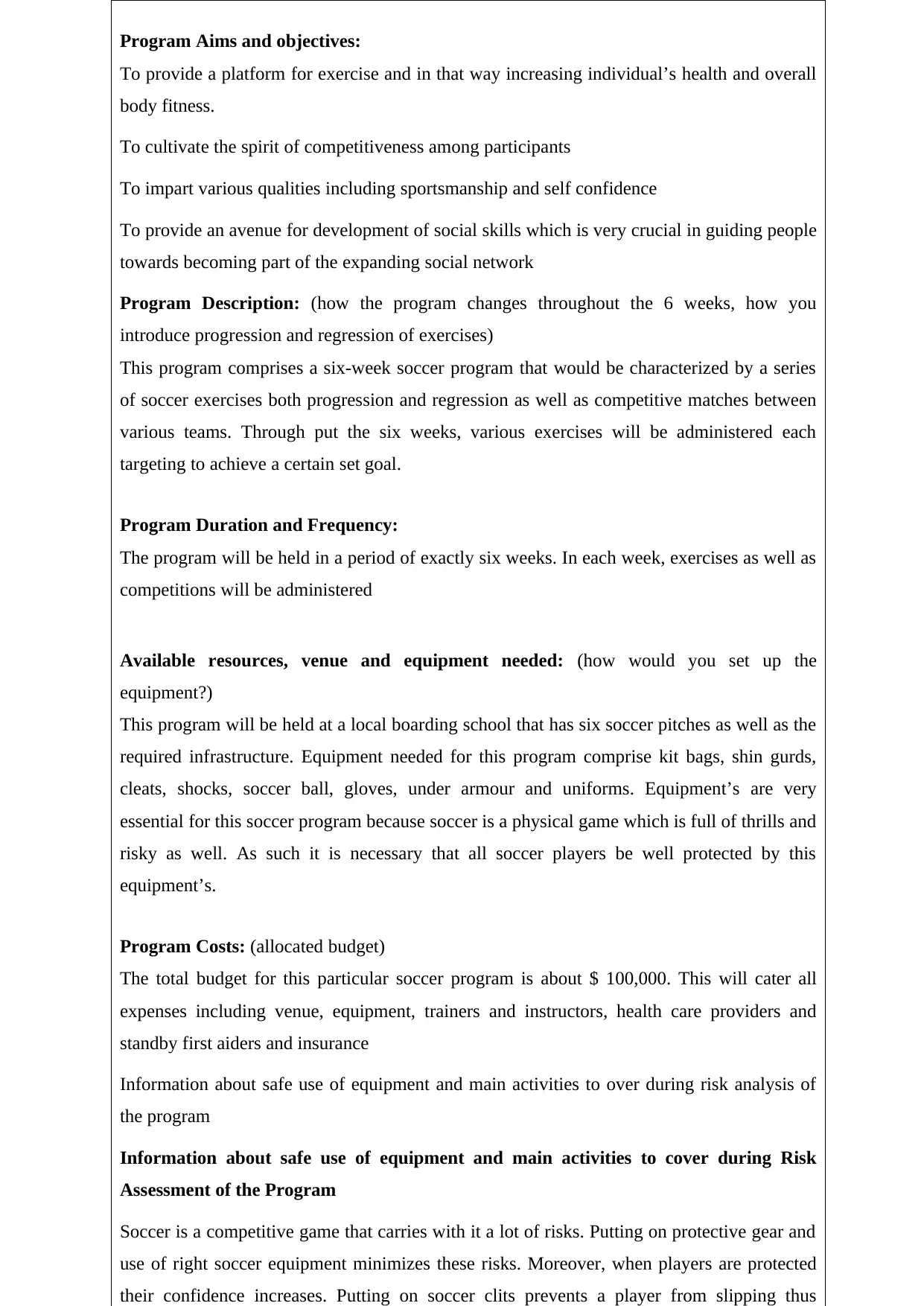
Program Aims and objectives:
To provide a platform for exercise and in that way increasing individual’s health and overall
body fitness.
To cultivate the spirit of competitiveness among participants
To impart various qualities including sportsmanship and self confidence
To provide an avenue for development of social skills which is very crucial in guiding people
towards becoming part of the expanding social network
Program Description: (how the program changes throughout the 6 weeks, how you
introduce progression and regression of exercises)
This program comprises a six-week soccer program that would be characterized by a series
of soccer exercises both progression and regression as well as competitive matches between
various teams. Through put the six weeks, various exercises will be administered each
targeting to achieve a certain set goal.
Program Duration and Frequency:
The program will be held in a period of exactly six weeks. In each week, exercises as well as
competitions will be administered
Available resources, venue and equipment needed: (how would you set up the
equipment?)
This program will be held at a local boarding school that has six soccer pitches as well as the
required infrastructure. Equipment needed for this program comprise kit bags, shin gurds,
cleats, shocks, soccer ball, gloves, under armour and uniforms. Equipment’s are very
essential for this soccer program because soccer is a physical game which is full of thrills and
risky as well. As such it is necessary that all soccer players be well protected by this
equipment’s.
Program Costs: (allocated budget)
The total budget for this particular soccer program is about $ 100,000. This will cater all
expenses including venue, equipment, trainers and instructors, health care providers and
standby first aiders and insurance
Information about safe use of equipment and main activities to over during risk analysis of
the program
Information about safe use of equipment and main activities to cover during Risk
Assessment of the Program
Soccer is a competitive game that carries with it a lot of risks. Putting on protective gear and
use of right soccer equipment minimizes these risks. Moreover, when players are protected
their confidence increases. Putting on soccer clits prevents a player from slipping thus
To provide a platform for exercise and in that way increasing individual’s health and overall
body fitness.
To cultivate the spirit of competitiveness among participants
To impart various qualities including sportsmanship and self confidence
To provide an avenue for development of social skills which is very crucial in guiding people
towards becoming part of the expanding social network
Program Description: (how the program changes throughout the 6 weeks, how you
introduce progression and regression of exercises)
This program comprises a six-week soccer program that would be characterized by a series
of soccer exercises both progression and regression as well as competitive matches between
various teams. Through put the six weeks, various exercises will be administered each
targeting to achieve a certain set goal.
Program Duration and Frequency:
The program will be held in a period of exactly six weeks. In each week, exercises as well as
competitions will be administered
Available resources, venue and equipment needed: (how would you set up the
equipment?)
This program will be held at a local boarding school that has six soccer pitches as well as the
required infrastructure. Equipment needed for this program comprise kit bags, shin gurds,
cleats, shocks, soccer ball, gloves, under armour and uniforms. Equipment’s are very
essential for this soccer program because soccer is a physical game which is full of thrills and
risky as well. As such it is necessary that all soccer players be well protected by this
equipment’s.
Program Costs: (allocated budget)
The total budget for this particular soccer program is about $ 100,000. This will cater all
expenses including venue, equipment, trainers and instructors, health care providers and
standby first aiders and insurance
Information about safe use of equipment and main activities to over during risk analysis of
the program
Information about safe use of equipment and main activities to cover during Risk
Assessment of the Program
Soccer is a competitive game that carries with it a lot of risks. Putting on protective gear and
use of right soccer equipment minimizes these risks. Moreover, when players are protected
their confidence increases. Putting on soccer clits prevents a player from slipping thus
⊘ This is a preview!⊘
Do you want full access?
Subscribe today to unlock all pages.

Trusted by 1+ million students worldwide
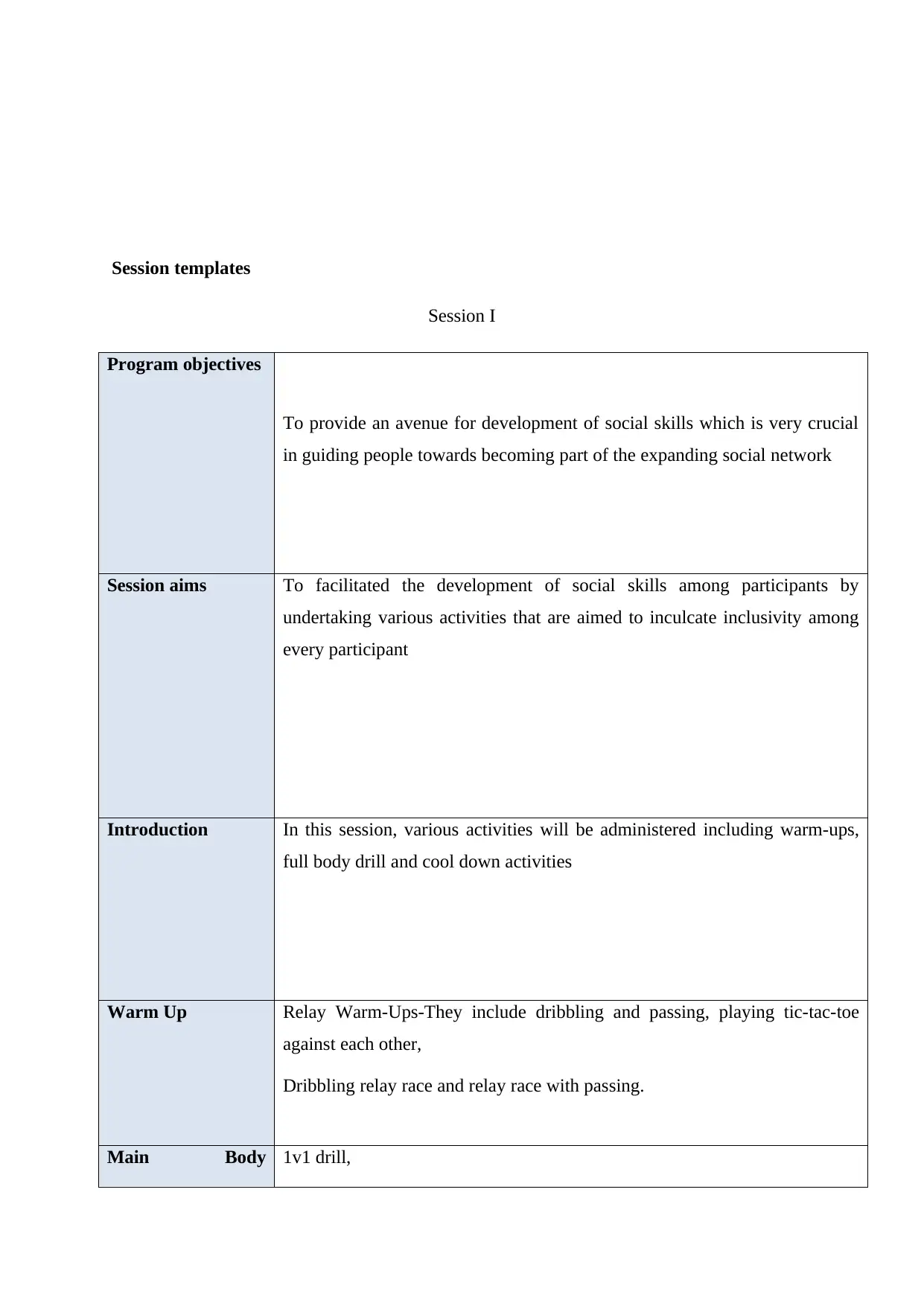
Session templates
Session I
Program objectives
To provide an avenue for development of social skills which is very crucial
in guiding people towards becoming part of the expanding social network
Session aims To facilitated the development of social skills among participants by
undertaking various activities that are aimed to inculcate inclusivity among
every participant
Introduction In this session, various activities will be administered including warm-ups,
full body drill and cool down activities
Warm Up Relay Warm-Ups-They include dribbling and passing, playing tic-tac-toe
against each other,
Dribbling relay race and relay race with passing.
Main Body 1v1 drill,
Session I
Program objectives
To provide an avenue for development of social skills which is very crucial
in guiding people towards becoming part of the expanding social network
Session aims To facilitated the development of social skills among participants by
undertaking various activities that are aimed to inculcate inclusivity among
every participant
Introduction In this session, various activities will be administered including warm-ups,
full body drill and cool down activities
Warm Up Relay Warm-Ups-They include dribbling and passing, playing tic-tac-toe
against each other,
Dribbling relay race and relay race with passing.
Main Body 1v1 drill,
Paraphrase This Document
Need a fresh take? Get an instant paraphrase of this document with our AI Paraphraser
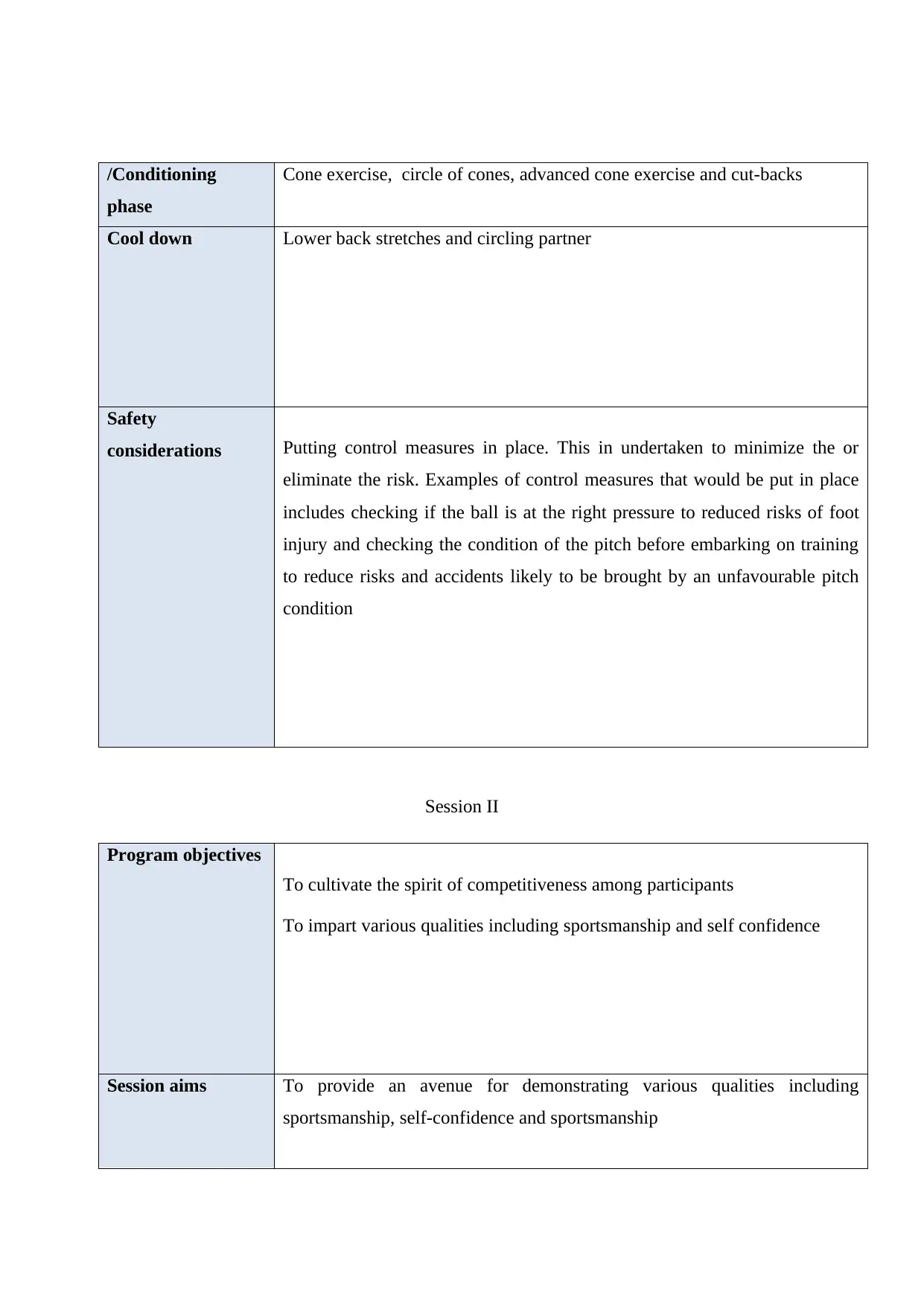
/Conditioning
phase
Cone exercise, circle of cones, advanced cone exercise and cut-backs
Cool down Lower back stretches and circling partner
Safety
considerations Putting control measures in place. This in undertaken to minimize the or
eliminate the risk. Examples of control measures that would be put in place
includes checking if the ball is at the right pressure to reduced risks of foot
injury and checking the condition of the pitch before embarking on training
to reduce risks and accidents likely to be brought by an unfavourable pitch
condition
Session II
Program objectives
To cultivate the spirit of competitiveness among participants
To impart various qualities including sportsmanship and self confidence
Session aims To provide an avenue for demonstrating various qualities including
sportsmanship, self-confidence and sportsmanship
phase
Cone exercise, circle of cones, advanced cone exercise and cut-backs
Cool down Lower back stretches and circling partner
Safety
considerations Putting control measures in place. This in undertaken to minimize the or
eliminate the risk. Examples of control measures that would be put in place
includes checking if the ball is at the right pressure to reduced risks of foot
injury and checking the condition of the pitch before embarking on training
to reduce risks and accidents likely to be brought by an unfavourable pitch
condition
Session II
Program objectives
To cultivate the spirit of competitiveness among participants
To impart various qualities including sportsmanship and self confidence
Session aims To provide an avenue for demonstrating various qualities including
sportsmanship, self-confidence and sportsmanship
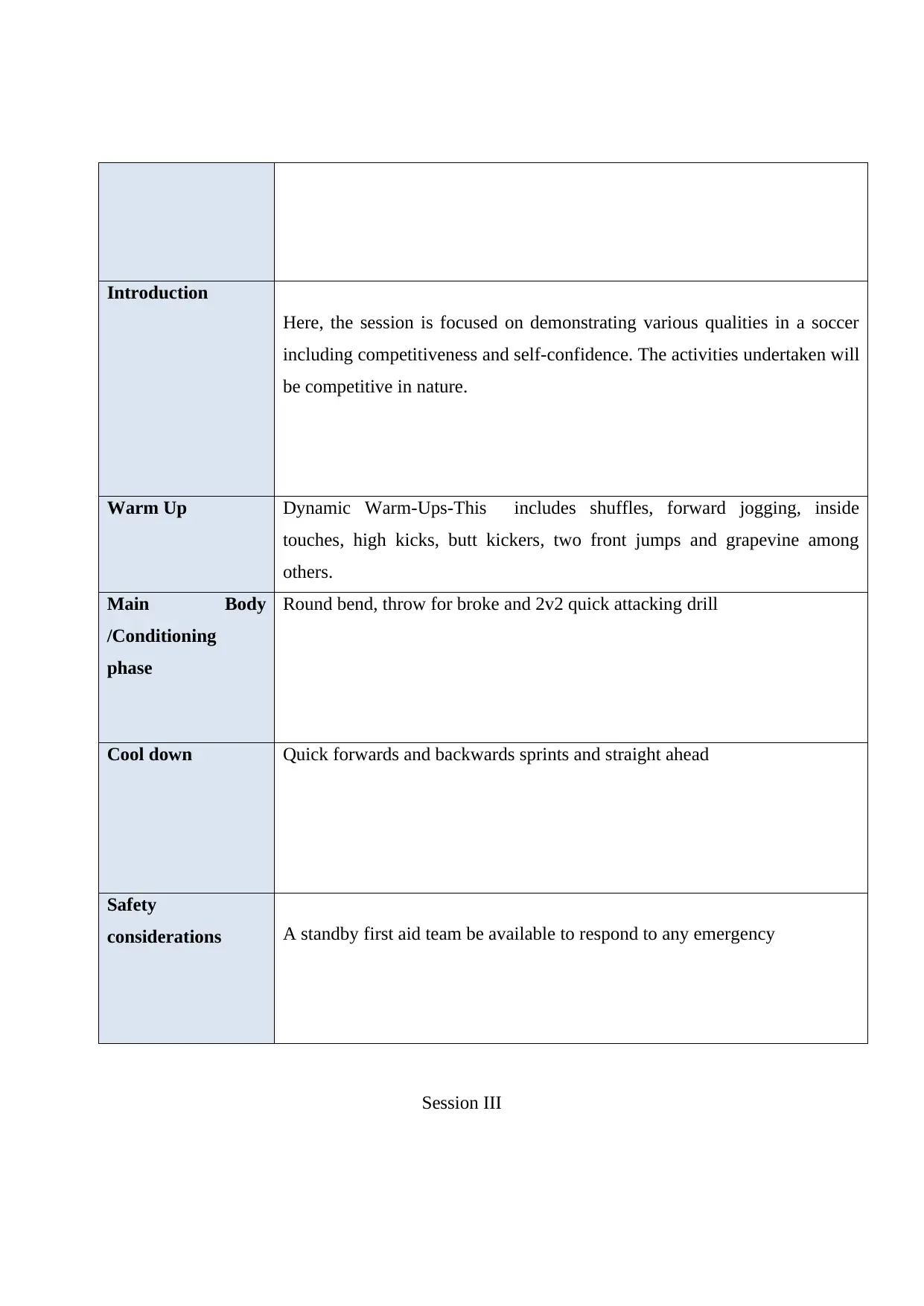
Introduction
Here, the session is focused on demonstrating various qualities in a soccer
including competitiveness and self-confidence. The activities undertaken will
be competitive in nature.
Warm Up Dynamic Warm-Ups-This includes shuffles, forward jogging, inside
touches, high kicks, butt kickers, two front jumps and grapevine among
others.
Main Body
/Conditioning
phase
Round bend, throw for broke and 2v2 quick attacking drill
Cool down Quick forwards and backwards sprints and straight ahead
Safety
considerations A standby first aid team be available to respond to any emergency
Session III
Here, the session is focused on demonstrating various qualities in a soccer
including competitiveness and self-confidence. The activities undertaken will
be competitive in nature.
Warm Up Dynamic Warm-Ups-This includes shuffles, forward jogging, inside
touches, high kicks, butt kickers, two front jumps and grapevine among
others.
Main Body
/Conditioning
phase
Round bend, throw for broke and 2v2 quick attacking drill
Cool down Quick forwards and backwards sprints and straight ahead
Safety
considerations A standby first aid team be available to respond to any emergency
Session III
⊘ This is a preview!⊘
Do you want full access?
Subscribe today to unlock all pages.

Trusted by 1+ million students worldwide
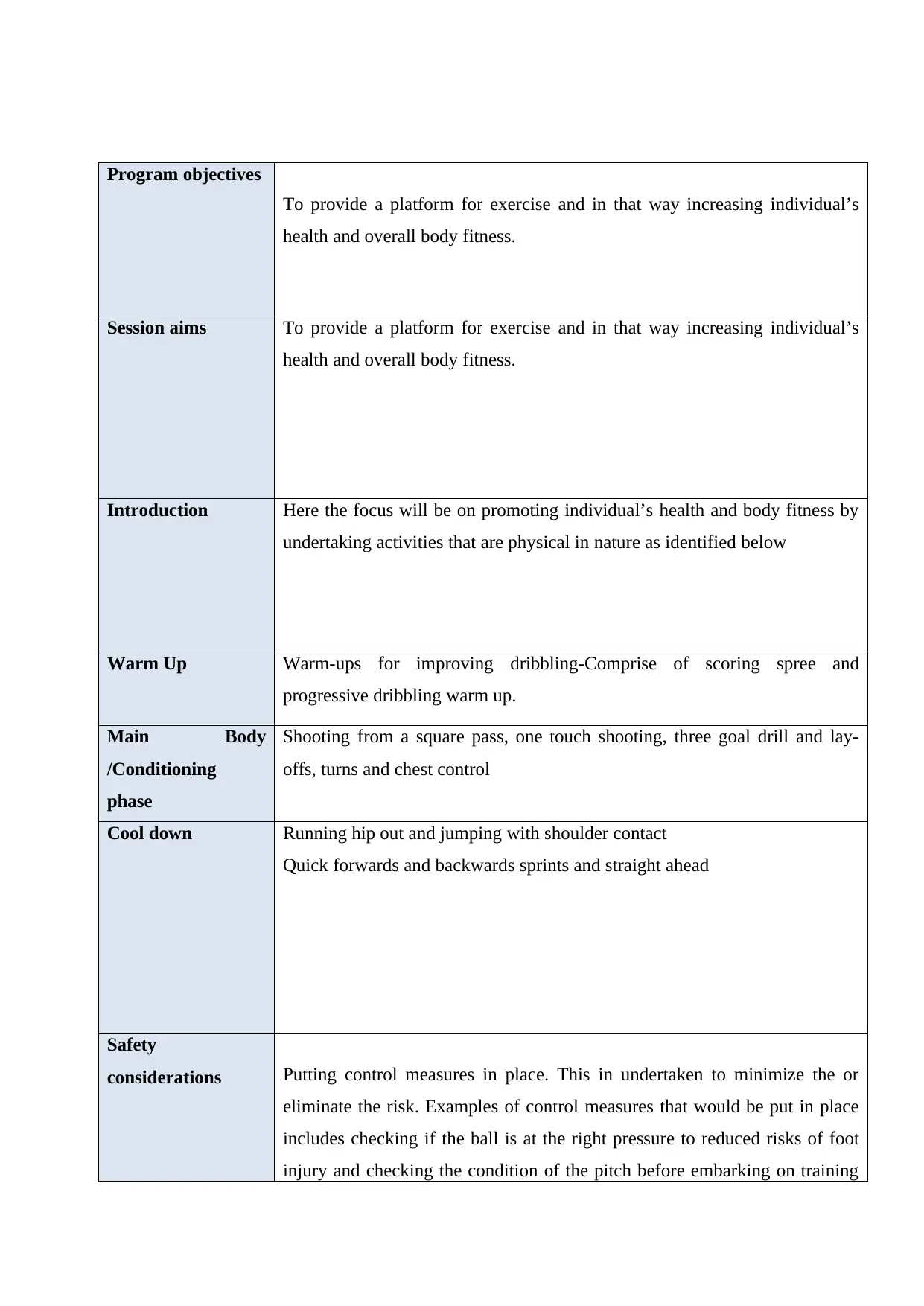
Program objectives
To provide a platform for exercise and in that way increasing individual’s
health and overall body fitness.
Session aims To provide a platform for exercise and in that way increasing individual’s
health and overall body fitness.
Introduction Here the focus will be on promoting individual’s health and body fitness by
undertaking activities that are physical in nature as identified below
Warm Up Warm-ups for improving dribbling-Comprise of scoring spree and
progressive dribbling warm up.
Main Body
/Conditioning
phase
Shooting from a square pass, one touch shooting, three goal drill and lay-
offs, turns and chest control
Cool down Running hip out and jumping with shoulder contact
Quick forwards and backwards sprints and straight ahead
Safety
considerations Putting control measures in place. This in undertaken to minimize the or
eliminate the risk. Examples of control measures that would be put in place
includes checking if the ball is at the right pressure to reduced risks of foot
injury and checking the condition of the pitch before embarking on training
To provide a platform for exercise and in that way increasing individual’s
health and overall body fitness.
Session aims To provide a platform for exercise and in that way increasing individual’s
health and overall body fitness.
Introduction Here the focus will be on promoting individual’s health and body fitness by
undertaking activities that are physical in nature as identified below
Warm Up Warm-ups for improving dribbling-Comprise of scoring spree and
progressive dribbling warm up.
Main Body
/Conditioning
phase
Shooting from a square pass, one touch shooting, three goal drill and lay-
offs, turns and chest control
Cool down Running hip out and jumping with shoulder contact
Quick forwards and backwards sprints and straight ahead
Safety
considerations Putting control measures in place. This in undertaken to minimize the or
eliminate the risk. Examples of control measures that would be put in place
includes checking if the ball is at the right pressure to reduced risks of foot
injury and checking the condition of the pitch before embarking on training
Paraphrase This Document
Need a fresh take? Get an instant paraphrase of this document with our AI Paraphraser
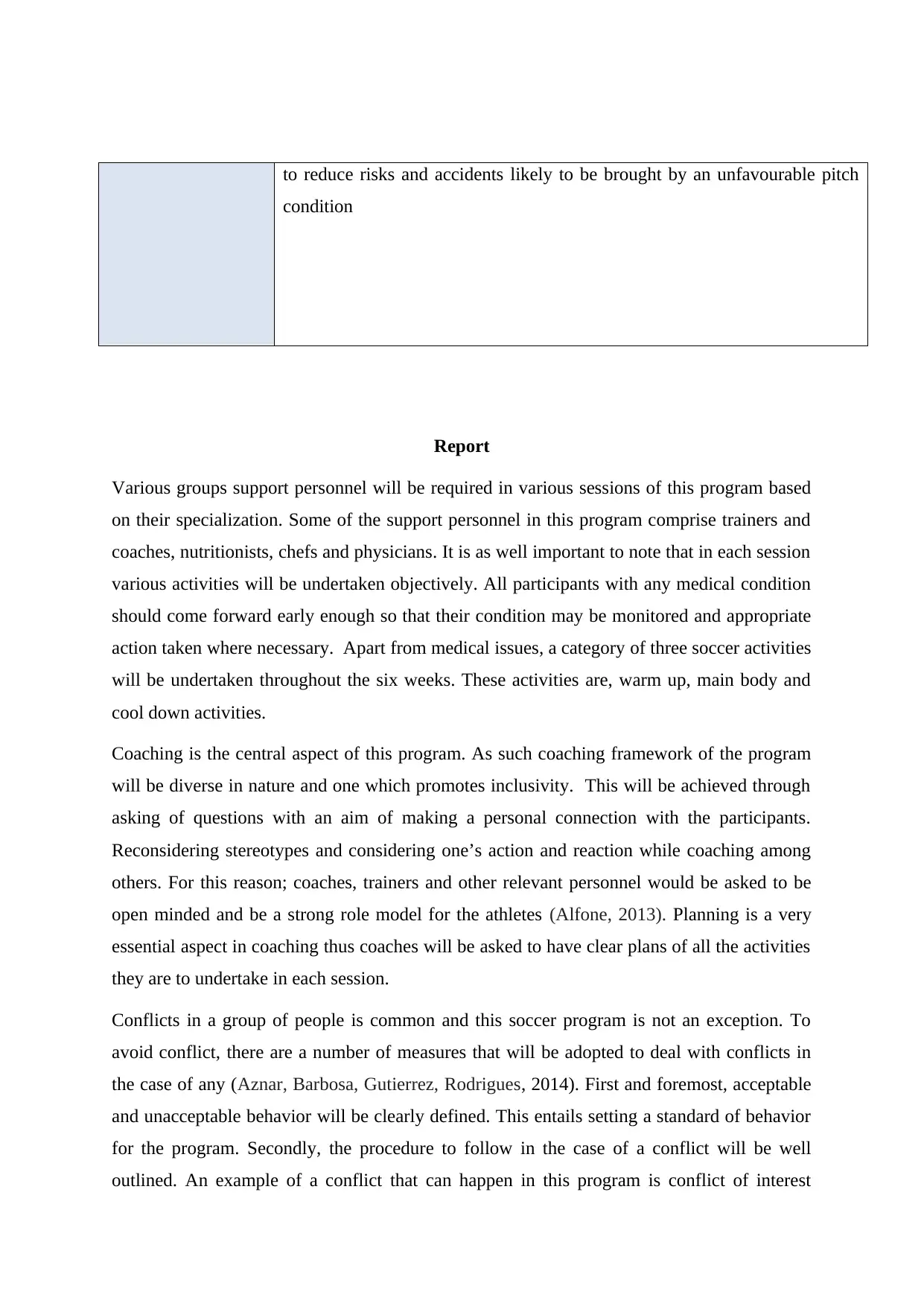
to reduce risks and accidents likely to be brought by an unfavourable pitch
condition
Report
Various groups support personnel will be required in various sessions of this program based
on their specialization. Some of the support personnel in this program comprise trainers and
coaches, nutritionists, chefs and physicians. It is as well important to note that in each session
various activities will be undertaken objectively. All participants with any medical condition
should come forward early enough so that their condition may be monitored and appropriate
action taken where necessary. Apart from medical issues, a category of three soccer activities
will be undertaken throughout the six weeks. These activities are, warm up, main body and
cool down activities.
Coaching is the central aspect of this program. As such coaching framework of the program
will be diverse in nature and one which promotes inclusivity. This will be achieved through
asking of questions with an aim of making a personal connection with the participants.
Reconsidering stereotypes and considering one’s action and reaction while coaching among
others. For this reason; coaches, trainers and other relevant personnel would be asked to be
open minded and be a strong role model for the athletes (Alfone, 2013). Planning is a very
essential aspect in coaching thus coaches will be asked to have clear plans of all the activities
they are to undertake in each session.
Conflicts in a group of people is common and this soccer program is not an exception. To
avoid conflict, there are a number of measures that will be adopted to deal with conflicts in
the case of any (Aznar, Barbosa, Gutierrez, Rodrigues, 2014). First and foremost, acceptable
and unacceptable behavior will be clearly defined. This entails setting a standard of behavior
for the program. Secondly, the procedure to follow in the case of a conflict will be well
outlined. An example of a conflict that can happen in this program is conflict of interest
condition
Report
Various groups support personnel will be required in various sessions of this program based
on their specialization. Some of the support personnel in this program comprise trainers and
coaches, nutritionists, chefs and physicians. It is as well important to note that in each session
various activities will be undertaken objectively. All participants with any medical condition
should come forward early enough so that their condition may be monitored and appropriate
action taken where necessary. Apart from medical issues, a category of three soccer activities
will be undertaken throughout the six weeks. These activities are, warm up, main body and
cool down activities.
Coaching is the central aspect of this program. As such coaching framework of the program
will be diverse in nature and one which promotes inclusivity. This will be achieved through
asking of questions with an aim of making a personal connection with the participants.
Reconsidering stereotypes and considering one’s action and reaction while coaching among
others. For this reason; coaches, trainers and other relevant personnel would be asked to be
open minded and be a strong role model for the athletes (Alfone, 2013). Planning is a very
essential aspect in coaching thus coaches will be asked to have clear plans of all the activities
they are to undertake in each session.
Conflicts in a group of people is common and this soccer program is not an exception. To
avoid conflict, there are a number of measures that will be adopted to deal with conflicts in
the case of any (Aznar, Barbosa, Gutierrez, Rodrigues, 2014). First and foremost, acceptable
and unacceptable behavior will be clearly defined. This entails setting a standard of behavior
for the program. Secondly, the procedure to follow in the case of a conflict will be well
outlined. An example of a conflict that can happen in this program is conflict of interest
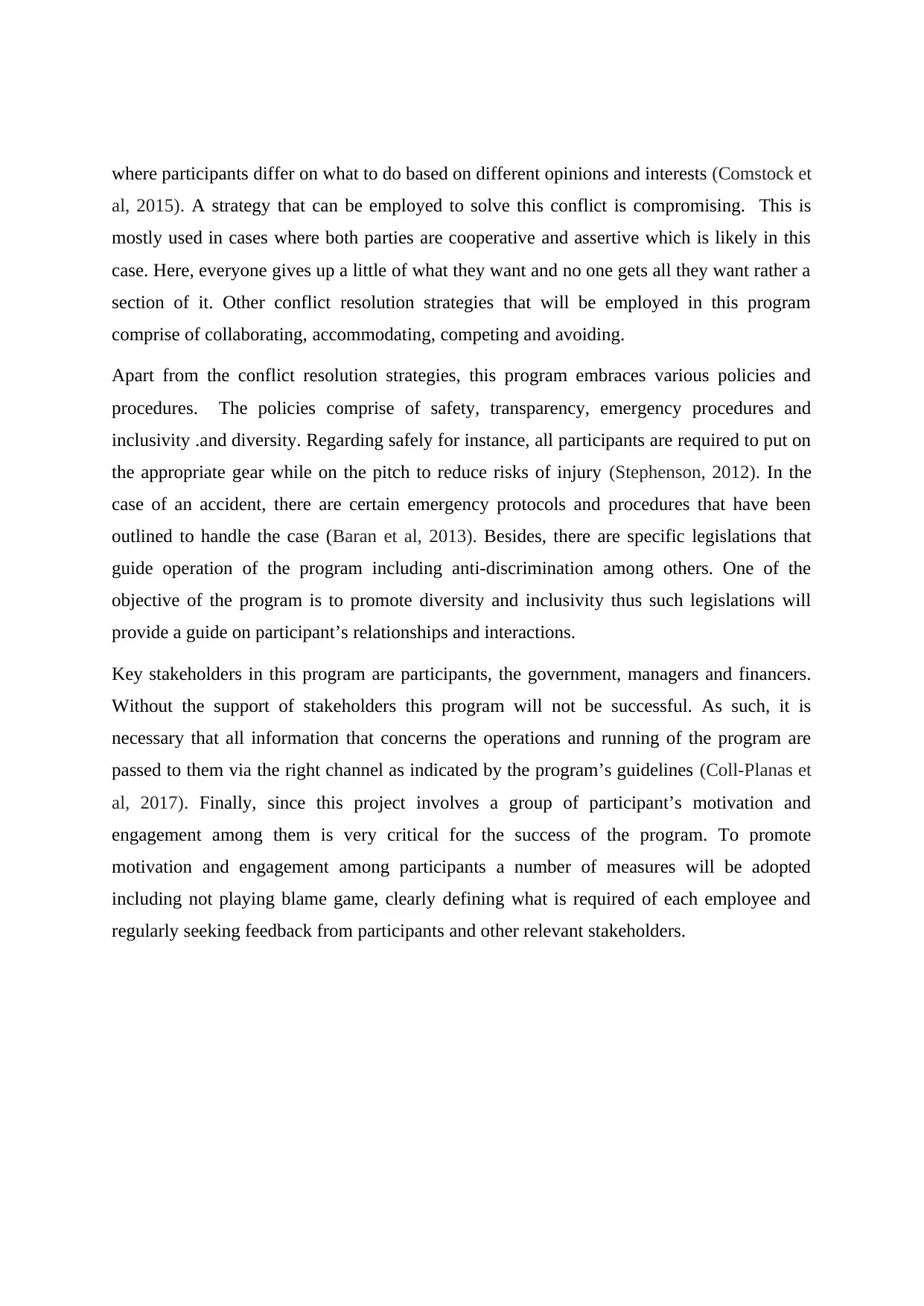
where participants differ on what to do based on different opinions and interests (Comstock et
al, 2015). A strategy that can be employed to solve this conflict is compromising. This is
mostly used in cases where both parties are cooperative and assertive which is likely in this
case. Here, everyone gives up a little of what they want and no one gets all they want rather a
section of it. Other conflict resolution strategies that will be employed in this program
comprise of collaborating, accommodating, competing and avoiding.
Apart from the conflict resolution strategies, this program embraces various policies and
procedures. The policies comprise of safety, transparency, emergency procedures and
inclusivity .and diversity. Regarding safely for instance, all participants are required to put on
the appropriate gear while on the pitch to reduce risks of injury (Stephenson, 2012). In the
case of an accident, there are certain emergency protocols and procedures that have been
outlined to handle the case (Baran et al, 2013). Besides, there are specific legislations that
guide operation of the program including anti-discrimination among others. One of the
objective of the program is to promote diversity and inclusivity thus such legislations will
provide a guide on participant’s relationships and interactions.
Key stakeholders in this program are participants, the government, managers and financers.
Without the support of stakeholders this program will not be successful. As such, it is
necessary that all information that concerns the operations and running of the program are
passed to them via the right channel as indicated by the program’s guidelines (Coll-Planas et
al, 2017). Finally, since this project involves a group of participant’s motivation and
engagement among them is very critical for the success of the program. To promote
motivation and engagement among participants a number of measures will be adopted
including not playing blame game, clearly defining what is required of each employee and
regularly seeking feedback from participants and other relevant stakeholders.
al, 2015). A strategy that can be employed to solve this conflict is compromising. This is
mostly used in cases where both parties are cooperative and assertive which is likely in this
case. Here, everyone gives up a little of what they want and no one gets all they want rather a
section of it. Other conflict resolution strategies that will be employed in this program
comprise of collaborating, accommodating, competing and avoiding.
Apart from the conflict resolution strategies, this program embraces various policies and
procedures. The policies comprise of safety, transparency, emergency procedures and
inclusivity .and diversity. Regarding safely for instance, all participants are required to put on
the appropriate gear while on the pitch to reduce risks of injury (Stephenson, 2012). In the
case of an accident, there are certain emergency protocols and procedures that have been
outlined to handle the case (Baran et al, 2013). Besides, there are specific legislations that
guide operation of the program including anti-discrimination among others. One of the
objective of the program is to promote diversity and inclusivity thus such legislations will
provide a guide on participant’s relationships and interactions.
Key stakeholders in this program are participants, the government, managers and financers.
Without the support of stakeholders this program will not be successful. As such, it is
necessary that all information that concerns the operations and running of the program are
passed to them via the right channel as indicated by the program’s guidelines (Coll-Planas et
al, 2017). Finally, since this project involves a group of participant’s motivation and
engagement among them is very critical for the success of the program. To promote
motivation and engagement among participants a number of measures will be adopted
including not playing blame game, clearly defining what is required of each employee and
regularly seeking feedback from participants and other relevant stakeholders.
⊘ This is a preview!⊘
Do you want full access?
Subscribe today to unlock all pages.

Trusted by 1+ million students worldwide
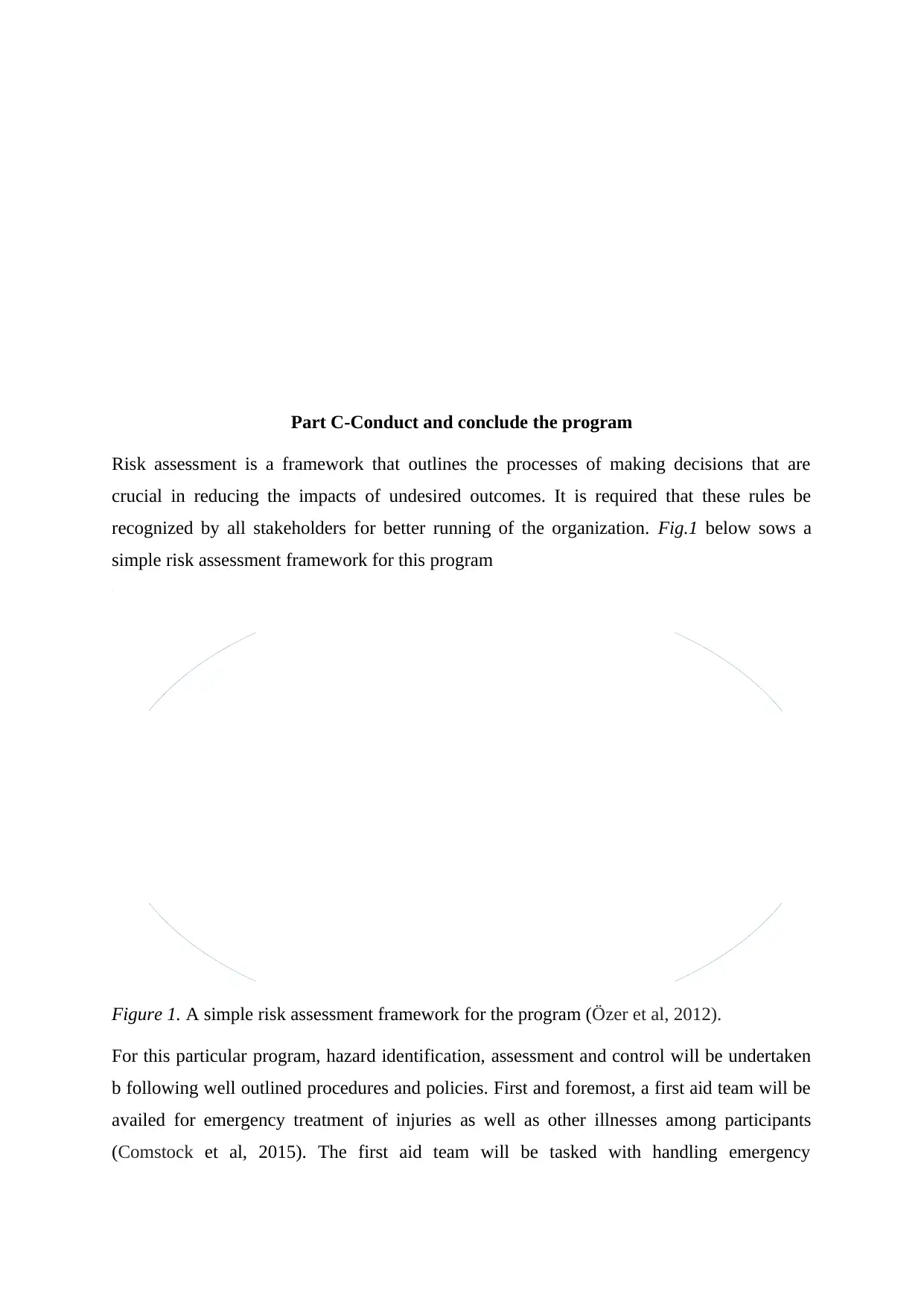
Part C-Conduct and conclude the program
Risk assessment is a framework that outlines the processes of making decisions that are
crucial in reducing the impacts of undesired outcomes. It is required that these rules be
recognized by all stakeholders for better running of the organization. Fig.1 below sows a
simple risk assessment framework for this program
Figure 1. A simple risk assessment framework for the program (Özer et al, 2012).
For this particular program, hazard identification, assessment and control will be undertaken
b following well outlined procedures and policies. First and foremost, a first aid team will be
availed for emergency treatment of injuries as well as other illnesses among participants
(Comstock et al, 2015). The first aid team will be tasked with handling emergency
Identi fyi ngpossi blehanz ard s
Apply ingcontr ols
Revie wi ng
effec t
Asses sin grisk
Risk assessment is a framework that outlines the processes of making decisions that are
crucial in reducing the impacts of undesired outcomes. It is required that these rules be
recognized by all stakeholders for better running of the organization. Fig.1 below sows a
simple risk assessment framework for this program
Figure 1. A simple risk assessment framework for the program (Özer et al, 2012).
For this particular program, hazard identification, assessment and control will be undertaken
b following well outlined procedures and policies. First and foremost, a first aid team will be
availed for emergency treatment of injuries as well as other illnesses among participants
(Comstock et al, 2015). The first aid team will be tasked with handling emergency
Identi fyi ngpossi blehanz ard s
Apply ingcontr ols
Revie wi ng
effec t
Asses sin grisk
Paraphrase This Document
Need a fresh take? Get an instant paraphrase of this document with our AI Paraphraser
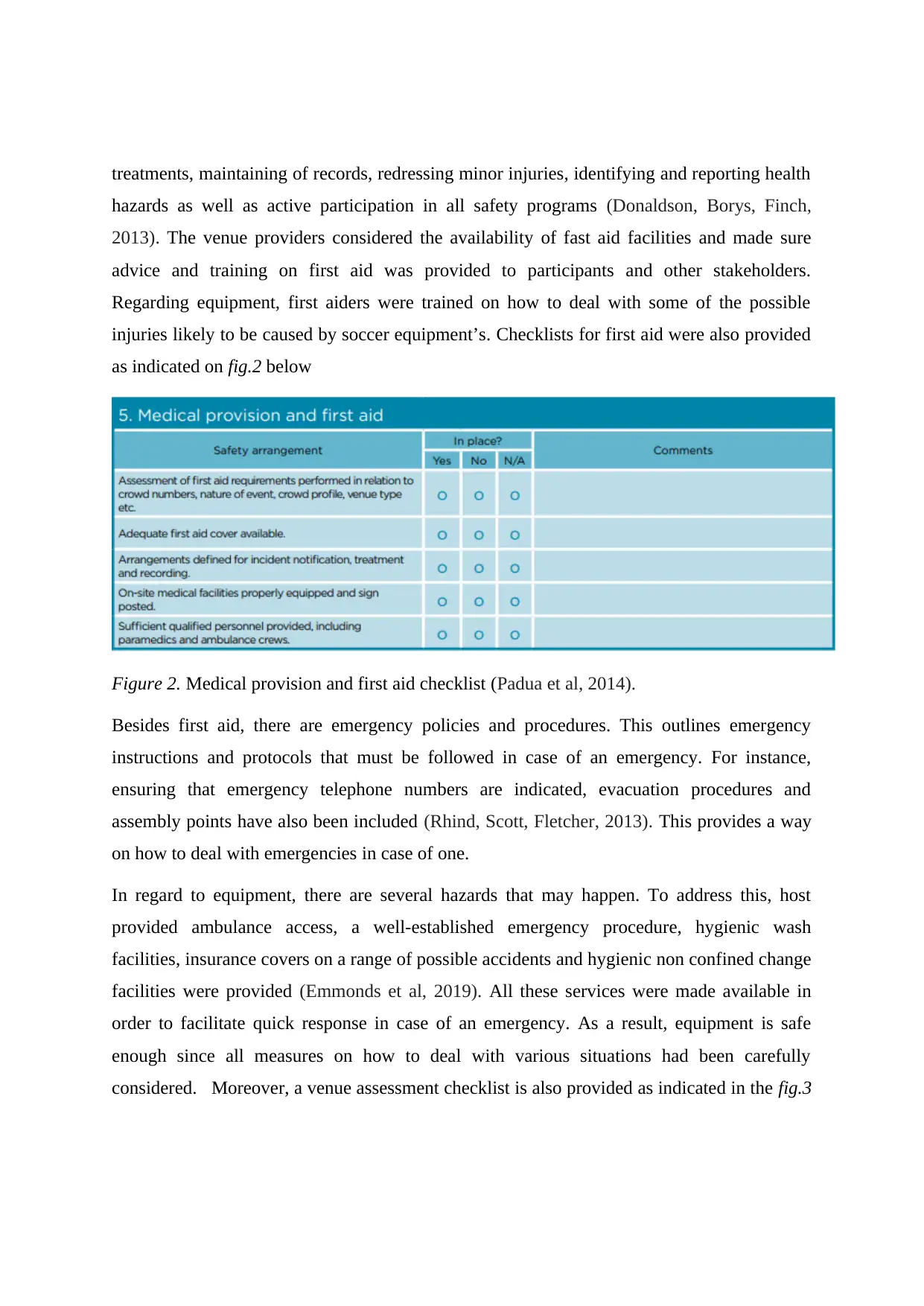
treatments, maintaining of records, redressing minor injuries, identifying and reporting health
hazards as well as active participation in all safety programs (Donaldson, Borys, Finch,
2013). The venue providers considered the availability of fast aid facilities and made sure
advice and training on first aid was provided to participants and other stakeholders.
Regarding equipment, first aiders were trained on how to deal with some of the possible
injuries likely to be caused by soccer equipment’s. Checklists for first aid were also provided
as indicated on fig.2 below
Figure 2. Medical provision and first aid checklist (Padua et al, 2014).
Besides first aid, there are emergency policies and procedures. This outlines emergency
instructions and protocols that must be followed in case of an emergency. For instance,
ensuring that emergency telephone numbers are indicated, evacuation procedures and
assembly points have also been included (Rhind, Scott, Fletcher, 2013). This provides a way
on how to deal with emergencies in case of one.
In regard to equipment, there are several hazards that may happen. To address this, host
provided ambulance access, a well-established emergency procedure, hygienic wash
facilities, insurance covers on a range of possible accidents and hygienic non confined change
facilities were provided (Emmonds et al, 2019). All these services were made available in
order to facilitate quick response in case of an emergency. As a result, equipment is safe
enough since all measures on how to deal with various situations had been carefully
considered. Moreover, a venue assessment checklist is also provided as indicated in the fig.3
hazards as well as active participation in all safety programs (Donaldson, Borys, Finch,
2013). The venue providers considered the availability of fast aid facilities and made sure
advice and training on first aid was provided to participants and other stakeholders.
Regarding equipment, first aiders were trained on how to deal with some of the possible
injuries likely to be caused by soccer equipment’s. Checklists for first aid were also provided
as indicated on fig.2 below
Figure 2. Medical provision and first aid checklist (Padua et al, 2014).
Besides first aid, there are emergency policies and procedures. This outlines emergency
instructions and protocols that must be followed in case of an emergency. For instance,
ensuring that emergency telephone numbers are indicated, evacuation procedures and
assembly points have also been included (Rhind, Scott, Fletcher, 2013). This provides a way
on how to deal with emergencies in case of one.
In regard to equipment, there are several hazards that may happen. To address this, host
provided ambulance access, a well-established emergency procedure, hygienic wash
facilities, insurance covers on a range of possible accidents and hygienic non confined change
facilities were provided (Emmonds et al, 2019). All these services were made available in
order to facilitate quick response in case of an emergency. As a result, equipment is safe
enough since all measures on how to deal with various situations had been carefully
considered. Moreover, a venue assessment checklist is also provided as indicated in the fig.3
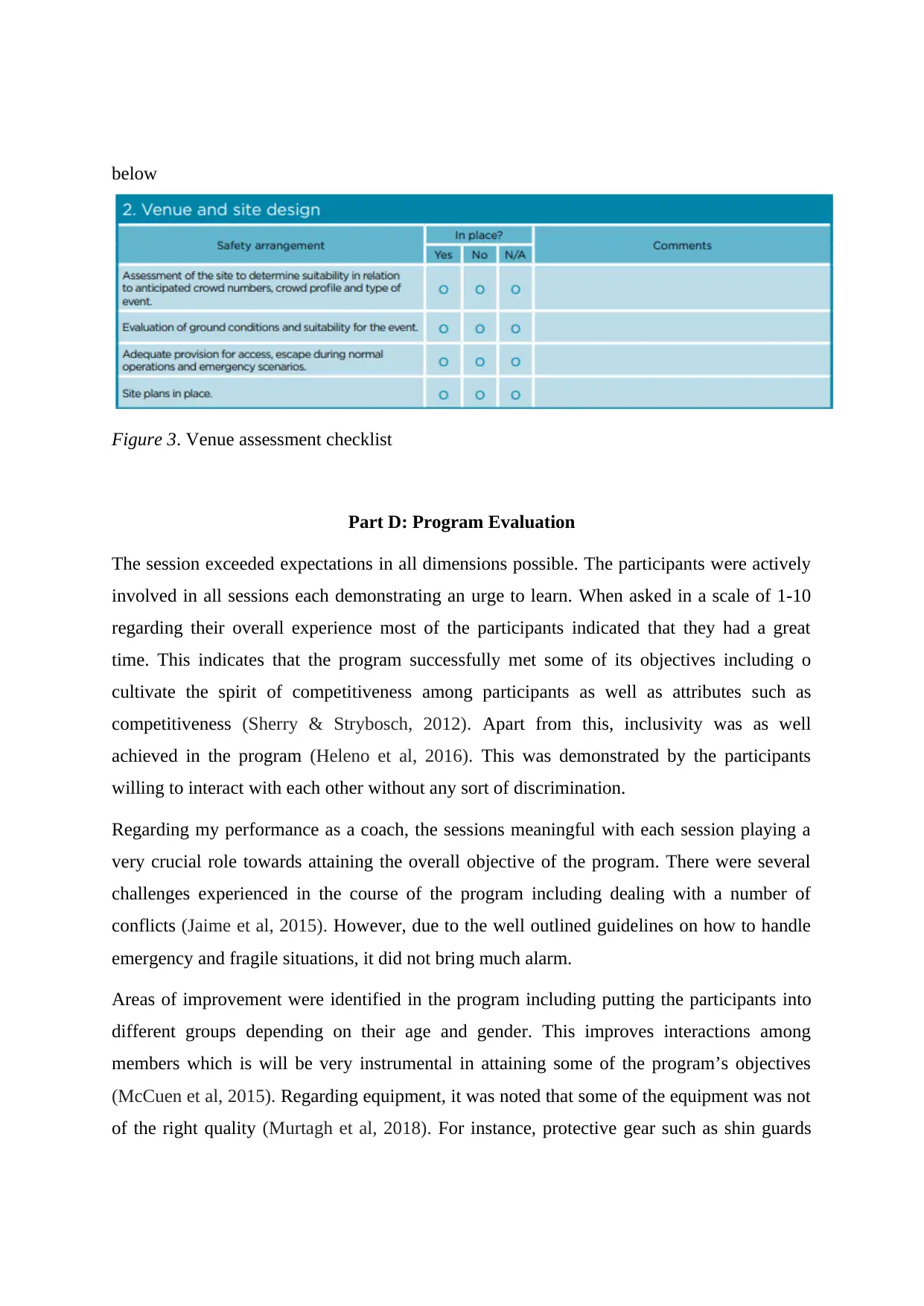
below
Figure 3. Venue assessment checklist
Part D: Program Evaluation
The session exceeded expectations in all dimensions possible. The participants were actively
involved in all sessions each demonstrating an urge to learn. When asked in a scale of 1-10
regarding their overall experience most of the participants indicated that they had a great
time. This indicates that the program successfully met some of its objectives including o
cultivate the spirit of competitiveness among participants as well as attributes such as
competitiveness (Sherry & Strybosch, 2012). Apart from this, inclusivity was as well
achieved in the program (Heleno et al, 2016). This was demonstrated by the participants
willing to interact with each other without any sort of discrimination.
Regarding my performance as a coach, the sessions meaningful with each session playing a
very crucial role towards attaining the overall objective of the program. There were several
challenges experienced in the course of the program including dealing with a number of
conflicts (Jaime et al, 2015). However, due to the well outlined guidelines on how to handle
emergency and fragile situations, it did not bring much alarm.
Areas of improvement were identified in the program including putting the participants into
different groups depending on their age and gender. This improves interactions among
members which is will be very instrumental in attaining some of the program’s objectives
(McCuen et al, 2015). Regarding equipment, it was noted that some of the equipment was not
of the right quality (Murtagh et al, 2018). For instance, protective gear such as shin guards
Figure 3. Venue assessment checklist
Part D: Program Evaluation
The session exceeded expectations in all dimensions possible. The participants were actively
involved in all sessions each demonstrating an urge to learn. When asked in a scale of 1-10
regarding their overall experience most of the participants indicated that they had a great
time. This indicates that the program successfully met some of its objectives including o
cultivate the spirit of competitiveness among participants as well as attributes such as
competitiveness (Sherry & Strybosch, 2012). Apart from this, inclusivity was as well
achieved in the program (Heleno et al, 2016). This was demonstrated by the participants
willing to interact with each other without any sort of discrimination.
Regarding my performance as a coach, the sessions meaningful with each session playing a
very crucial role towards attaining the overall objective of the program. There were several
challenges experienced in the course of the program including dealing with a number of
conflicts (Jaime et al, 2015). However, due to the well outlined guidelines on how to handle
emergency and fragile situations, it did not bring much alarm.
Areas of improvement were identified in the program including putting the participants into
different groups depending on their age and gender. This improves interactions among
members which is will be very instrumental in attaining some of the program’s objectives
(McCuen et al, 2015). Regarding equipment, it was noted that some of the equipment was not
of the right quality (Murtagh et al, 2018). For instance, protective gear such as shin guards
⊘ This is a preview!⊘
Do you want full access?
Subscribe today to unlock all pages.

Trusted by 1+ million students worldwide
1 out of 14
Your All-in-One AI-Powered Toolkit for Academic Success.
+13062052269
info@desklib.com
Available 24*7 on WhatsApp / Email
![[object Object]](/_next/static/media/star-bottom.7253800d.svg)
Unlock your academic potential
Copyright © 2020–2025 A2Z Services. All Rights Reserved. Developed and managed by ZUCOL.